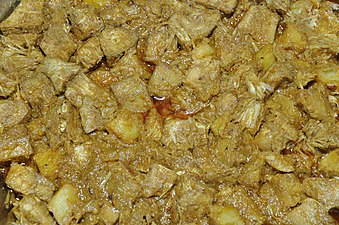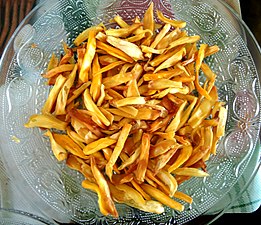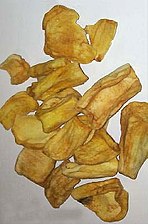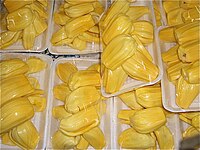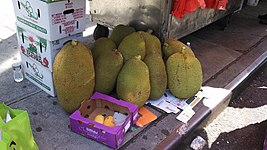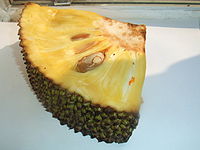Jackfruit
| Jackfruit | |
|---|---|

| |
| Scientific classification | |
| Kingdom: | Plantae |
| Clade: | Tracheophytes |
| Clade: | Angiosperms |
| Clade: | Eudicots |
| Clade: | Rosids |
| Order: | Rosales |
| Family: | Moraceae |
| Genus: | Artocarpus |
| Species: | A. heterophyllus
|
| Binomial name | |
| Artocarpus heterophyllus | |
| Synonyms[3][4][5] | |
The jackfruit is the fruit of jack tree Artocarpus heterophyllus,
The jackfruit tree is well-suited to tropical
The ripe fruit is sweet (depending on variety) and is commonly used in desserts.
Both ripe and unripe fruits are consumed. It is available internationally, canned or frozen, and in chilled meals, as are various products derived from the fruit, such as noodles and chips.Etymology and common names
The word jackfruit comes from
The common English name "jackfruit" was used by physician and naturalist
Nangka is another name used in Philippine English[7] borrowing from Tagalog related to nangkà in Cebuano[21] and in Malay, both from the same Austronesian language family.[22]
History
The jackfruit was domesticated independently in the
Botanical description



This section needs additional citations for verification. (September 2023) |
Shape, trunk and leaves
Artocarpus heterophyllus grows as an evergreen tree that has a relatively short trunk and dense treetop. It easily reaches heights of 9 to 21 m (30 to 69 feet)[7] and trunk diameters of 30 to 80 cm (12 to 31 inches). It sometimes forms buttress roots. The bark of the jackfruit tree is reddish-brown and smooth. In the event of injury to the bark, a milky sap is released.[7]
The leaves are
In young trees, the leaf edges are irregularly lobed or split. On older trees, the leaves are rounded and dark green, with a smooth leaf margin. The leaf blade has a prominent main
Flowers

The
The flowers are small, sitting on a fleshy rachis.[26] The male flowers are greenish, some flowers are sterile. The male flowers are hairy and the perianth ends with two 1 to 1.5 mm (3⁄64 to 1⁄16 in) membrane. The individual and prominent stamens are straight with yellow, roundish anthers. Pollen grains are tiny, around 60 microns in diameter. After the pollen distribution, the stamens become ash-gray and fall off after a few days. Later, all the male inflorescences also fall off. The greenish female flowers, with hairy and tubular perianth, have a fleshy flower-like base. The female flowers contain an ovary with a broad, capitate, or rarely bilobed scar. The blooming time ranges from December until February or March.

Fruit
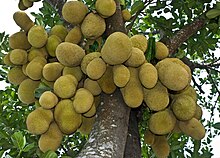

The ellipsoidal to roundish fruit is a multiple fruit formed from the fusion of the ovaries of multiple flowers.[7][8]The fruits grow on a long and thick stem on the trunk. They vary in size and ripen from an initially yellowish-greenish to yellow, and then at maturity to yellowish-brown. They possess a hard, gummy shell with small pimples surrounded with hard, hexagonal tubercles.[7] The large and variously shaped fruit have a length of 30 to 100 cm (10 to 40 inches) and a diameter of 15 to 50 cm (6 to 20 inches) and can weigh up to 55 kg (121 pounds) – the largest of all tree-borne fruits.[7][8][27]
The fruits consist of a fibrous, whitish core (rachis) about 5–10 cm (2–4 inches) thick. Radiating from this are many 10-centimeter-long (4 in) individual fruits. They are elliptical to egg-shaped, light brownish achenes with a length of about 3 cm (1+1⁄8 inches) and a diameter of 1.5 to 2 cm (9⁄16 to 13⁄16 inch).
There may be about 100–500 seeds per fruit.[7] The seed coat consists of a thin, waxy, parchment-like and easily removable testa (husk) and a brownish, membranous tegmen. The cotyledons are usually unequal in size, and the endosperm is minimally present.[28] An average fruit consists of 27% edible seed coat, 15% edible seeds, 20% white pulp (undeveloped perianth, rags) and bark and 10% core.
The fruit matures during the rainy season from July to August. The bean-shaped achenes of the jackfruit are coated with a firm yellowish aril (seed coat, flesh), which has an intense sweet taste at maturity of the fruit. The pulp is enveloped by many narrow strands of fiber (undeveloped perianth), which run between the hard shell and the core of the fruit and are firmly attached to it. When pruned, the inner part (core) secretes a sticky, milky liquid,[7] which can hardly be removed from the skin, even with soap and water. To clean the hands after "unwinding" the pulp an oil or other solvent is used. For example, street vendors in Tanzania, who sell the fruit in small segments, provide small bowls of kerosene for their customers to cleanse their sticky fingers. When fully ripe, jackfruit has a strong pleasant aroma, the pulp of the opened fruit resembles the odor of pineapple and banana.[7]
Uses
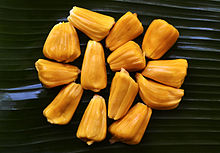

Ripe jackfruit is naturally sweet, with subtle pineapple- or banana-like flavor.
The seeds from ripe fruits are edible once cooked, and are said to have a milky, sweet taste often compared to Brazil nuts. They may be boiled, baked, or roasted.[7] When roasted, the flavor of the seeds is comparable to chestnuts. Seeds are used as snacks (either by boiling or fire-roasting) or to make desserts. In Java, the seeds are commonly cooked and seasoned with salt as a snack. They are commonly used in curry in India in the form of a traditional lentil and vegetable mix curry. Young leaves are tender enough to be used as a vegetable.[7]
Nutritional value
| Nutritional value per 100 g (3.5 oz) | |
|---|---|
| Energy | 397 kJ (95 kcal) |
23.25 g | |
| Sugars | 19.08 g |
| Dietary fiber | 1.5 g |
0.64 g | |
1.72 g | |
Niacin (B3) | 6% 0.92 mg |
| Pantothenic acid (B5) | 5% 0.235 mg |
| Vitamin B6 | 19% 0.329 mg |
| Folate (B9) | 6% 24 μg |
| Vitamin C | 15% 13.8 mg |
| Vitamin E | 2% 0.34 mg |
| Minerals | Quantity %DV† |
| Calcium | 2% 24 mg |
| Iron | 1% 0.23 mg |
| Magnesium | 7% 29 mg |
| Manganese | 2% 0.043 mg |
| Phosphorus | 2% 21 mg |
| Potassium | 15% 448 mg |
| Sodium | 0% 2 mg |
| Zinc | 1% 0.13 mg |
| Other constituents | Quantity |
| Water | 73.5 g |
| †Percentages estimated using US recommendations for adults,[29] except for potassium, which is estimated based on expert recommendation from the National Academies.[30] | |
The edible pulp is 74% water, 23%
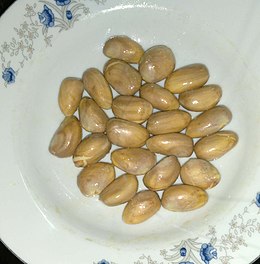
The jackfruit is a partial solution for
Culinary
This section needs additional citations for verification. (May 2018) |
The flavor of the ripe fruit is comparable to a combination of apple, pineapple, mango, and banana.
The cuisines of many Asian countries use cooked young jackfruit.[13] In many cultures, jackfruit is boiled and used in curries as a staple food. The boiled young jackfruit is used in salads or as a vegetable in spicy curries and side dishes, and as fillings for cutlets and chops. It may be used by vegetarians as a substitute for meat such as pulled pork, though the protein content of the fruit is not significant. It may be cooked with coconut milk and eaten alone or with meat, shrimp or smoked pork. In southern India, unripe jackfruit slices are deep-fried to make chips. The jackfruit seeds are also boiled and used in sambar (stew).
Aroma
This section needs additional citations for verification. (October 2021) |
Jackfruit has a distinctive sweet and fruity aroma. In a study of flavour volatiles in five jackfruit cultivars, the main
A fully ripe and unopened jackfruit is known to "emit a strong aroma" – perhaps unpleasant[7][33] – with the inside of the fruit described as smelling of pineapple and banana.[7] After roasting, the seeds may be used as a commercial alternative to chocolate aroma.[34]
South Asia
In Bangladesh, the fruit is consumed on its own. The unripe fruit is used in curry, and the seed is often dried and preserved to be later used in curry.[35] In India, two varieties of jackfruit predominate: muttomvarikka and sindoor. Muttomvarikka has a slightly hard inner flesh when ripe, while the inner flesh of the ripe sindoor fruit is soft.[36]
A sweet preparation called chakkavaratti (jackfruit jam) is made by seasoning pieces of muttomvarikka fruit flesh in jaggery, which can be preserved and used for many months. The fruits are either eaten alone or as a side to rice. The juice is extracted and either drunk straight or as a side. The juice is sometimes condensed and eaten as candies. The seeds are either boiled or roasted and eaten with salt and hot chilies. They are also used to make spicy side dishes with rice. Jackfruit may be ground and made into a paste, then spread over a mat and allowed to dry in the sun to create a natural chewy candy.
-
Jackfruit curry (Sri Lanka)
-
Green jackfruit and potato curry (West Bengal)
-
Jackfruit masala (India)
-
Jackfruit fried in coconut oil from Kerala, India
-
Jackfruit (unripe) cutlet, India
Southeast Asia
In Indonesia and Malaysia, jackfruit is called nangka. The ripe fruit is usually sold separately and consumed on its own, or sliced and mixed with shaved ice as a sweet concoction dessert such as es campur and es teler. The ripe fruit might be dried and fried as kripik nangka, or jackfruit cracker. The seeds are boiled and consumed with salt, as they contain edible starchy content; this is called beton. Young (unripe) jackfruit is made into curry called gulai nangka or stewed called gudeg.
In the Philippines, unripe jackfruit or langka is usually cooked in coconut milk and eaten with rice; this is called ginataang langka.[37] The ripe fruit is often an ingredient in local desserts such as halo-halo and the Filipino turon. The ripe fruit, besides also being eaten raw as it is, is also preserved by storing in syrup or by drying. The seeds are also boiled before being eaten.
Thailand is a major producer of jackfruit, which are often cut, prepared, and canned in a sugary syrup (or frozen in bags or boxes without syrup) and exported overseas, frequently to North America and Europe.
In Vietnam, jackfruit is used to make jackfruit chè, a sweet dessert soup, similar to the Chinese derivative bubur cha cha. The Vietnamese also use jackfruit purée as part of pastry fillings or as a topping on xôi ngọt (a sweet version of sticky rice portions).
Jackfruits are found primarily in the eastern part of Taiwan. The fresh fruit can be eaten directly or preserved as dried fruit, candied fruit, or jam. It is also stir-fried or stewed with other vegetables and meat.
-
Kripik nangka, jackfruit chips (Indonesia)
-
Gudeg (left), jackfruit curry with palm sugar (Indonesia)
-
Halo-halo, shaved ice dessert with various fruits and toppings (Philippines)
Americas
In Brazil, three varieties are recognized: jaca-dura, or the "hard" variety, which has a firm flesh, and the largest fruits that can weigh between 15 and 40 kg each; jaca-mole, or the "soft" variety, which bears smaller fruits with a softer and sweeter flesh; and jaca-manteiga, or the "butter" variety, which bears sweet fruits whose flesh has a consistency intermediate between the "hard" and "soft" varieties.[38]
Africa
From a tree planted for its shade in gardens, it became an ingredient for local recipes using different fruit segments. The seeds are boiled in water or roasted to remove toxic substances, and then roasted for a variety of desserts. The flesh of the unripe jackfruit is used to make a savory salty dish with smoked pork. The jackfruit arils are used to make jams or fruits in syrup, and can also be eaten raw.
Materials
Wood and manufacturing
The golden yellow timber with good grain is used for building furniture and house construction in India. It is termite-resistant[39] and is superior to teak for building furniture. The wood of the jackfruit tree is important in Sri Lanka and is exported to Europe. Jackfruit wood is widely used in the manufacture of furniture, doors and windows, in roof construction,[7] and fish sauce barrels.[40]
The wood of the tree is used for the production of musical instruments. In Indonesia, hardwood from the trunk is carved out to form the barrels of drums used in the
Cultural significance
The jackfruit has played a significant role in Indian agriculture for centuries. Archaeological findings in India have revealed that jackfruit was cultivated in India 3000 to 6000 years ago.[42] It has also been widely cultivated in Southeast Asia.
The ornate wooden plank called avani palaka, made of the wood of the jackfruit tree, is used as the priest's seat during Hindu ceremonies in Kerala. In Vietnam, jackfruit wood is prized for the making of Buddhist statues in temples[43] The heartwood is used by Buddhist forest monastics in Southeast Asia as a dye, giving the robes of the monks in those traditions their distinctive light-brown color.[44]
Jackfruit is the national fruit of Bangladesh,[35] and the state fruit of the Indian states of Kerala (which hosts jackfruit festivals) and Tamil Nadu.[45][46]
Cultivation
In terms of taking care of the plant, minimal pruning is required; cutting off dead branches from the interior of the tree is only sometimes needed.[7] In addition, twigs bearing fruit must be twisted or cut down to the trunk to induce growth for the next season.[7] Branches should be pruned every three to four years to maintain productivity.[7]
Some trees carry too many mediocre fruits and these are usually removed to allow the others to develop better to maturity.
Stingless bees such as Tetragonula iridipennis are jackfruit pollinators, and so play an important role in jackfruit cultivation.[citation needed] It seems to be the case that pollination results from a three-way mutualism involving the flower, a fungus, and a species of gall midge, Clinidiplosis ultracrepidata. The fungus forms a film over the syncarps which is a food source to both the fly larvae and adults.[47]
Production and marketing
In 2017, India produced 1.4 million tonnes of jackfruit, followed by Bangladesh, Thailand, and Indonesia.[48]
The marketing of jackfruit involves three groups: producers, traders, and
-
Packed jackfruit sold in a market
-
Selling jackfruit in Bangkok
-
Jackfruit at a fruit stand in Manhattan's Chinatown
-
Cut jackfruit
-
Polythene-packaged cut jackfruit
-
Extracting the jackfruit arils and separating the seeds from the flesh
Commercial availability
Outside countries of origin, fresh jackfruit can be found at food markets throughout Southeast Asia.

Jackfruit is also widely available year-round, both canned and dried. Dried jackfruit chips are produced by various manufacturers. As reported in 2019, jackfruit became more widely available in US grocery stores, cleaned and ready to cook, as well as in premade dishes or prepared ingredients.[51] It is on restaurant menus in preparations such as taco fillings and vegan versions of pulled pork dishes.[51]
Invasive species
In Brazil, the jackfruit can become an
The species has expanded excessively because its fruits, which naturally fall to the ground and open, are eagerly eaten by small mammals, such as the common marmoset and coati. The seeds are then dispersed by these animals, spreading jackfruit trees that compete for space with native tree species. The supply of jackfruit has allowed the marmoset and coati populations to expand. Since both prey opportunistically on bird eggs and nestlings, the increases in marmoset and coati populations are detrimental to local birds.[citation needed]
See also
- Domesticated plants and animals of Austronesia
- Chempedak, a closely related Southeast Asian fruit sometimes confused with jackfruit
- Durian, a fruit similar in appearance but from an unrelated tree, also from Southeast Asia
References
- ^ Under its accepted name Artocarpus heterophyllus (then as heterophylla) this species was described in Encyclopédie Méthodique, Botanique 3: 209. (1789) by Jean-Baptiste Lamarck, from a specimen collected by botanist Philibert Commerson. Lamarck said of the fruit that it was coarse and difficult to digest. Larmarck's original description of tejas. Vol. t.3. Panckoucke;Plomteux. 1789. Retrieved 23 November 2012.
On mange la chair de son fruit, ainsi que les noyaux qu'il contient; mais c'est un aliment grossier et difficile à digérer.
- ^ "Name - !Artocarpus heterophyllus Lam". Tropicos. Saint Louis, Missouri: Missouri Botanical Garden. Retrieved 23 November 2012.
- ^ "Artocarpus heterophyllus Lam". World Flora Online. World Flora Consortium. 2023. Retrieved 3 September 2023.
- ^ "Name – Artocarpus heterophyllus Lam. synonyms". Tropicos. Saint Louis, Missouri: Missouri Botanical Garden. Retrieved 23 November 2012.
- ^ "Artocarpus heterophyllus". Germplasm Resources Information Network. Agricultural Research Service, United States Department of Agriculture. Retrieved 23 November 2012.
- ^ "Artocarpus heterophyllus". Tropical Biology Association. October 2006. Archived from the original on 15 August 2012. Retrieved 23 November 2012.
- ^ ISBN 0-9610184-1-0. Retrieved 19 April 2016.
- ^ a b c d e "Jackfruit Fruit Facts". California Rare Fruit Growers, Inc. 1996. Retrieved 3 September 2023.
- ^ a b Love, Ken; Paull, Robert E (June 2011). "Jackfruit" (PDF). College of Tropical Agriculture and Human Resources, University of Hawaii at Manoa.
- ^ a b c Silver, Mark (May 2014). "Here's The Scoop On Jackfruit, A Ginormous Fruit To Feed The World". NPR. Retrieved 19 April 2016.
- ^ Boning, Charles R. (2006). Florida's Best Fruiting Plants:Native and Exotic Trees, Shrubs, and Vines. Sarasota, Florida: Pineapple Press, Inc. p. 107.
- ISBN 9780970254450.
- ^ a b c Janick, Jules; Paull, Robert E. The encyclopedia of fruit & nuts (PDF). p. 155.
- ^ The encyclopedia of fruit & nuts, By Jules Janick, Robert E. Paull, pp. 481–485
- ISBN 978-81-89422-49-3.
The English name jackfruit is derived from Portuguese jaca, which is derived from Malayalam chakka,
- ^ Friar Jordanus (1863). Mirabilia descripta: the wonders of the East. Hakluyt Society. p. 13. Retrieved 23 November 2012.
- ISBN 9781134317769– via Google Books.
- ^ Oxford English Dictionary, Second Edition, 1989, online edition
- ^ The American Heritage Dictionary of the English Language: Fourth Edition. Bartleby. 2000. Archived from the original on 30 November 2005.
- JSTOR 1222028.
- ^ Wolff, John U. (1972). "Nangkà" (PDF). A Dictionary of Cebuano Visayan. Vol. 2. p. 698.
- ^ a b Blust, Robert; Trussel, Stephen:
- "Loans: jackfruit - Artocarpus spp.". Austronesian Comparative Dictionary. Max Planck Institute for Evolutionary Anthropology. 2010. Retrieved 17 July 2023.
- Blust, Robert; Trussel, Stephen (2013). "The Austronesian Comparative Dictionary: A Work in Progress". Oceanic Linguistics. 52 (2): 493–523. S2CID 146739541.
- ISBN 9784902325331.
- ^ "Jackfruit – National Fruit of Bangladesh". By Bangladesh.com. Retrieved 5 April 2021.
- ^ "Jackfruit Declared as Official State Fruit of Kerala; Proposal by the Agriculture Department". India.com. 21 March 2018. Retrieved 12 January 2023.
- ^ Pushpakumara, D. K. N. G. (2006). "Floral and Fruit Morphology and Phenology of Artocarpus heterophyllus Lam. (Moraceae)". Sri Lankan J. Agric. Sci. 43: 82–106.
- ^ Herrmann, Bridget; Cooper, Lucy (11 April 2024). "Jumbo jackfruit harvested at Feluga as demand for the popular vegan, vegetarian meat alternative grows". ABC News. Retrieved 11 April 2024.
- ]
- ^ United States Food and Drug Administration (2024). "Daily Value on the Nutrition and Supplement Facts Labels". Retrieved 28 March 2024.
- )
- ^ Mwandambo, Pascal (11 March 2014). "Venture in rare jackfruit turns farmers' fortunes around". Standard Online. Standard Group Ltd. Retrieved 20 December 2016.
- .
- ISBN 9780910690027.
- PMID 28110526.
- ^ a b Matin, Abdul. "A poor man's fruit: Now a miracle food!". The Daily Star. Retrieved 12 June 2015.
- ^ Ashwini. A (2015). Morpho-Molecular Characterization of Jackfruit. Artocarpus heterophyllus (Thesis). Kerala Agricultural University.
- ^ "Ginataang Langka (Jackfruit in Coconut Milk)". Filipino Chow. 20 May 2018. Retrieved 19 April 2019.
- ^ General information Archived 2009-04-13 at the Wayback Machine, Department of Agriculture, State of Bahia
- ^ Bali, KALIUDA Gallery (30 January 2021). "All About Jackfruit Wood or Jackwood". KALIUDA Gallery Bali. Retrieved 17 September 2021.
- ^ "Nam O fish sauce village". Danang Today. 26 February 2014. Retrieved 22 September 2015.
- ISSN 2335-2124.
- ISBN 978-0-12-375689-3.
- ^ "Gỗ mít nài". Nhagoviethung.com. Archived from the original on 3 April 2017. Retrieved 17 June 2014.
- ^ Forest Monks and the Nation-state: An Anthropological and Historical Study in Northeast Thailand, J.L. Taylor 1993 p. 218
- ^ Subrahmanian, N.; Hikosaka, Shu; Samuel, G. John; Thiagarajan, P. (1997). Tamil social history. Institute of Asian Studies. p. 88. Retrieved 23 March 2010.
- ^ "Kerala's State fruit!". Retrieved 17 March 2018.
- ISBN 9780143134275.
- ^ Benjamin Elisha Sawe (25 April 2017). "World Leaders In Jackfruit Production". WorldAtlas. Retrieved 23 May 2018.
- ISBN 978-0-85432-785-0. Archived from the original(PDF) on 5 October 2012.
- ^ a b Goldenberg, Suzanne (23 April 2014). "Jackfruit heralded as 'miracle' food crop". The Guardian, London, UK. Retrieved 17 October 2016.
- ^ a b Brian Kateman (20 August 2019). "This Ancient 'Miracle Fruit' Is The Latest Meat Replacement Craze". Forbes. Retrieved 2 September 2019.
- ^ "Danger or delight? Uphill battle for Brazil's huge jackfruit". ABC News.
External links
 Jackfruit at the Wikibooks Cookbook subproject
Jackfruit at the Wikibooks Cookbook subproject Media related to Artocarpus heterophyllus (category) at Wikimedia Commons
Media related to Artocarpus heterophyllus (category) at Wikimedia Commons Data related to Artocarpus heterophyllus at Wikispecies
Data related to Artocarpus heterophyllus at Wikispecies The dictionary definition of jackfruit at Wiktionary
The dictionary definition of jackfruit at Wiktionary


